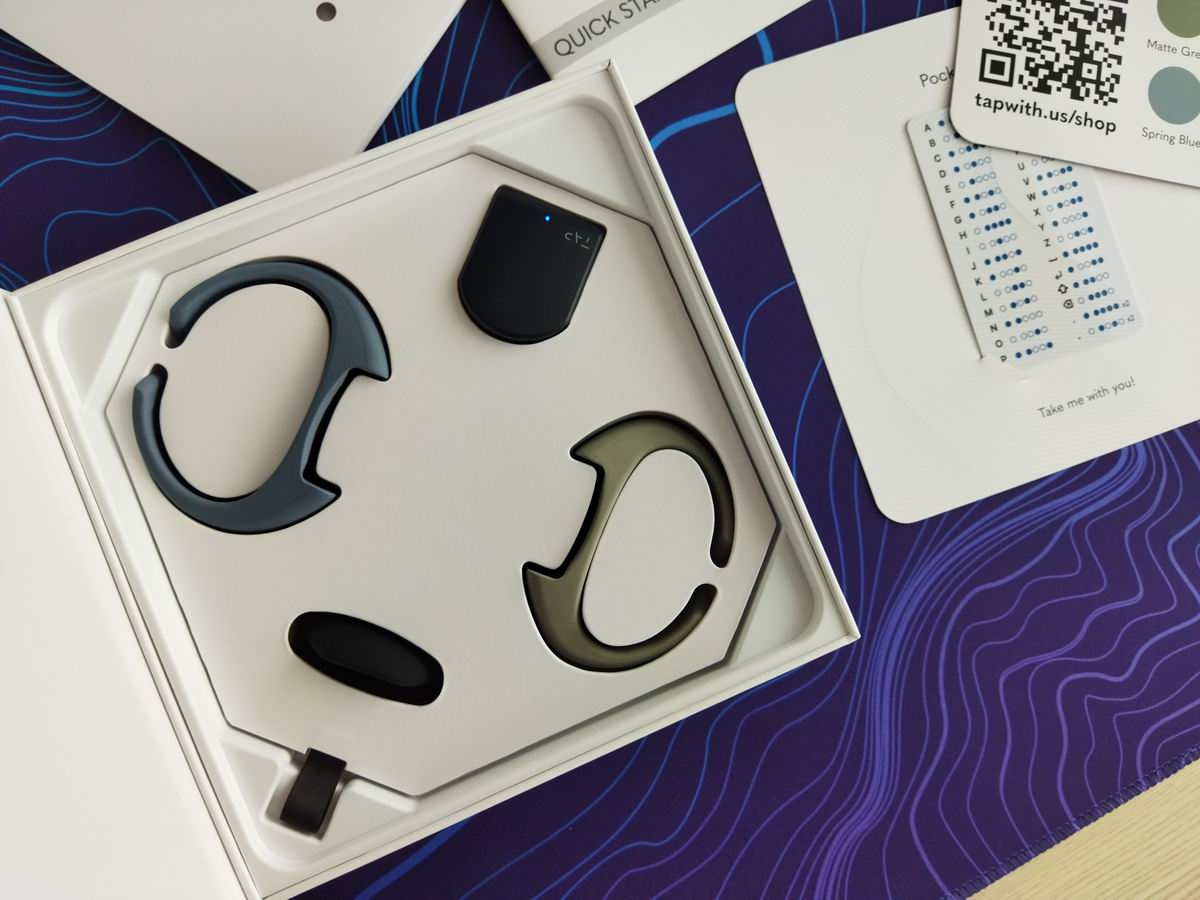Keyboard Builders' Digest / Review
TapXR review
The TapXR is a wrist-worn device: keyboard, mouse & controller in one. It's a fun gadget but works best within its closed ecosystem.
Published April 22, 2024

In contrast to the finger-worn Tap Strap, the first product by Tap Systems, the latest TapXR is a wrist-worn device: keyboard, mouse & controller in one. I've been testing it for two weeks, here are my thoughts about the most unlikely keyboard I've ever witnessed, a camera tracking your fingers.
TLDR; You'll love or hate your TapXR. Is it cool? Definitely. Portable? Sort of. Reliable? Not really. Ergonomic? No. Pricey? It depends. All in all, the TapXR won't replace your keyboard but is a nice gadget and handy controller for some specific and limited use cases. That said, I'd recommend it only to early adopters who like to experiment while don't mind if they end up with a $250-300 gadget confined to a drawer.
So based on online ratings and feedback, many users seem to have a love-hate relationship with the TapXR and for good reason. Amazon ratings are wild, practically distributed between 5 and 1 stars. I can definitely understand both groups, but I can give you some tips on how to get over the initial frustration.
While there's a short manual in the box, I'd suggest to head to the more comprehensive online manual. Updating the firmware was my breakthrough moment, it results in a way more reliable input device, but the process has its own risks (more on this later). Plus download the TapManager app, play around with the tutorials, and try out some other apps of this small software ecosystem too.
Disclaimer
I received this review unit from the manufacturer. As always, this may introduce all kind of bias. Read everything with a grain of salt.
Unboxing
The packaging is super professional. The box opens magnetically, quality materials everywhere with a nice touch.
In the box: the sensor part of the device, two wrist bands (small and large), a credit card sized plastic cheat sheet with the default alphabet, charger station with cable, and manual – a shortened version as already mentioned.
Tap bands
The large wristband was perfect fit for me. The only problem is: I'm a skinny guy with relatively thin wrists compared to e.g. my co-workers who looked really funny when trying to squeeze their chunky limbs into the pure bracelet. Although the band is very flexible, I doubt it's comfy for many adult males, especially on the long run.
Learning the chords
Most of the default chords make sense, particularly if your only or main language is English. Learning it took half an hour at most, even before I discovered the tutorials in TapManager, and TapGenius, a dedicated learning and practice tool.
One-finger gestures (aeiou) are easy, if you are familiar with letter frequencies than you can guess a lot of consonants too (more frequent ones can be summoned by easier two-finger taps). There are a lot of visual cues (to symmetric alphas like IVMWY belong symmetric patterns), and you can come up with mnemonics too. When in doubt, especially with less frequent alphas, I memorized bigrams of mirrored gestures (NS, RH, KB, FX, CJ), so if you know one of these, you know the other one too.
While symbols are a bit harder to memorize, many of them make sense as well. Again, more frequent symbols are associated with easier taps.
TapManager and firmware update
While the TapXR can be used right out of the box, updating the firmware is recommended. The best way to do this is via TapManager, an app running on your phone, which offers some settings too: turn on/off haptic feedback, autocorrect, set doubletap timing, etc.
The firmware update process would take about 2-5 minutes normally – if it wouldn't fail at halfway, the device buzzing like crazy and the app prompting an error message… After four attempts without success, the device ran out of battery (needs to be over 50% to start the update). Better luck next time. […] I tried the update on the weekend so couldn't reach out for support, but after lots of unpairing and on/off cycles I finally succeeded. However, it required epic level of perseverance as it took me about 15-20(!) update attempts.
Nevertheless, the result is a whole new device. I'm not kidding: your whimsical source of frustration turns into a quite usable TapXR in an instant.
Customizing the layout
As already mentioned, the default keymap makes a lot of sense, assigning easier finger combos/chords to more frequently used letters of the English alphabet. However, there's a chance you won't use the TapXR for plain typing, or English only. That's when MapCreator may come in handy: a pretty versatile online app to make changes to the "keymap" or build it from scratch.
And this is important, because the TapXR excels as a controller, and you may end up setting up gestures to fire hotkeys accordingly. At least that's my gut feeling after all the testing.
Typing style & speed
The TapXR is definitely not for prolonged typing and coding, not to mention editing texts. One reason for that is the limitations of one-handed chords, the other the way you have to tap:
Fingers raised relatively high so the sensor can recognize the gesture as reliably as possible. You have to hover your wrist/forearm since there's a camera attached to it.
Two taps per second is fine, however, at three taps per second double- and triple-tap functions may start to activate, so basically it is not possible to type the same letter any faster even if you could technically (in theory, specs claim a 10 gesture/sec speed).
Translating this to familiar metrics: there's a hard cap on the effective speed somewhere between 36 and 48 WPM, at least for words with double letters.
You can adjust doubletap sensitivity, but then triggering symbols will be harder.
(For the record, on the TapWithUs sub there's a 84WPM run mentioned, it would be good to have a clear understanding of the conditions of the experiment. It's definitely not typical.)
Haptic feedback
The haptic feedback is great to indicate if you activate your shift or 'switch' layer (numbers, arrows and some other functions), or enter/exit the experimental air mouse mode.
I mean, a small buzz is great if you activate a layer intentiously. However, when triggering something accidentally, which may often happen, they don't really help as the buzz is the same in pretty much all these cases.
Portability
Well, I give four stars for portability. Which may sound plain stupid in case of a wrist band, probably the most easy to carry around device one can imagine. However, given it only works reliably(?) on a flat and possibly hard surface, that means a desk most of the time, its usage is pretty restricted.
The firmware update fixed some of these issues, but not entirely.
The promise of working on any surface is still an exaggeration.
Keyboard vs TapXR
No, the TapXR definitely can't replace a keyboard for typing, coding, gaming.
(Two-handed) chording in general is very powerful, but e.g. with stenography you produce one word per tap. The one-handed TapXR fires one character per tap.
The best use case for the TapXR is when it acts as a one-handed controller, e.g. for illustrators, when making music or controlling any major software with many hotkeys. Mouse or stylus in one hand, and all the hotkeys on the other via TapXR.
Ergonomics
Because it would block the sensor, you can't really rest your hands as usual. This is completely against my typing style as I rest my lower arms on the arm rests of my chair, or my palm on the palm rests of split keyboards. The TapXR won't work with this setup.
The only recommended way to rest your arm is on the edge of the table which may or may not work for you, it looks painful to me.
Another problem is the constant wrist extension and strain.
You tap by slightly raising your hand. On each tap. I can't even imagine calling this ergonomic. It's a lot of work compared to a properly set up keyboard. Strain is guaranteed in a few minutes.
Finally, your fingers don't move completely independently. If you were not aware of this earlier, trying to type "j"with the TapXR will teach you this.
Reliability
You should have a clear line of sight between the sensor and your fingertips, since the sensor is a camera.
The original firmware had a lot of issues with this, in my experience you couldn't really have objects beneath and around your hand either. Placing my tapping hand between a keyboard and mouse, with some cables in the background, the device was practically unusable. Lot's of disconnections too.
Again, update your firmware. It's much better now, however, far from perfect still.
Another issue worth pointing out is that the sensor is not infra, so you need some ambient light. For this reason, using the TapXR as a controller for TV may work at daylight but not in a dark room.
Finally, and this is the most frustrating, you can't really predict if it will work on a given surface or not. Sometimes it works on my lap, sometimes not. Sometimes it works perfectly on a desk, sometimes not. Sometimes it works acceptable in an almost completely dark environment, and turning off a lamp makes things worse. It's completely unpredictable.
AirMouse
This is still in beta mode, no settings either, but it has a great potential. With ergo boards the bottleneck is often the swap between the keyboard and mouse. With the TapXR, activating mouse mode is as easy as positioning your hand vertically.
Lot's of things to do yet, but this feature is very promising.
Overall experience
As soon as you could get the hang of it, you run into a new issue.
Discovering custom keymaps? How awesome! But the interface hangs after a few clicks. You've learnt the chords and want to work on your speed? Mis-taps drive you crazy and the device gets completely unresponsive as an ultimate test of my mental stability. Let's resolve the issue by updating the firmware! Sure. Here are some new error messages for you which will keep you busy for the rest of the day. :D
(I'm aware of the many positive reviews and genuinely don't get them. Mis-taps are a serious issue.)
So while it has a lot of potential, the unreliable behavior and gesture recognition of the TapXR renders the device a cool gadget rather than a reliable companion for work.
Pros
- portability
- build quality
- documentation, customization
Cons
- tapping is unreliable, unergonomic and inefficient
- it can't replace a keyboard for most use cases
- price
Conclusion
I had no problem with learning all the chords, I would love to create my own "keymap" and discover all the possibilities to unleash the full potential of the TapXR, but this needs preternatural level of dedication. I can't see how it could replace a keyboard in most use cases, but the TapXR is a cool gadget anyway. Mostly for early adopters who are ready to experiment and don't mind some frustration on the way.
Availability
- TapXR at tapwithus.com, now for
$299$249
Published on Mon 22nd Apr 2024. Featured in KBD #162.











